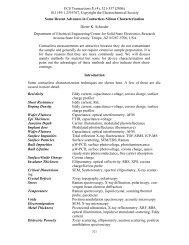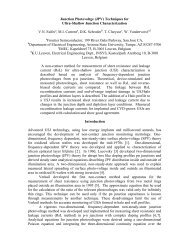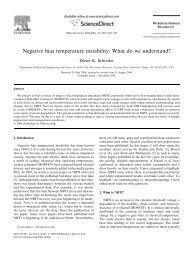The Role of the Mercury-Si Schottky-Barrier Height in ... - IEEE Xplore
The Role of the Mercury-Si Schottky-Barrier Height in ... - IEEE Xplore
The Role of the Mercury-Si Schottky-Barrier Height in ... - IEEE Xplore
You also want an ePaper? Increase the reach of your titles
YUMPU automatically turns print PDFs into web optimized ePapers that Google loves.
CHOI et al.: ROLE OF THE MERCURY-SI SCHOTTKY-BARRIER HEIGHT IN -MOSFET 1383<br />
Fig. 7. <strong>Si</strong>mulated I –V characteristics for a HgFET show<strong>in</strong>g <strong>the</strong><br />
effect <strong>of</strong> barrier height on electron and hole currents. t<br />
N =10 cm , N =10 cm , and V =0:6 V.<br />
Fig. 8.<br />
= 160 nm,<br />
Measured dra<strong>in</strong> current versus time for a HgFET before and after dilute<br />
HF etch. 200-mm-diameter bonded p-<strong>Si</strong>, t = 160 nm, t =145nm,<br />
and N =10 cm .<br />
and hole currents. Note <strong>the</strong> strong <strong>in</strong>fluence <strong>of</strong> barrier height,<br />
with changes <strong>of</strong> 0.2 eV lead<strong>in</strong>g to dra<strong>in</strong> current changes <strong>of</strong><br />
1000 . When one current type <strong>in</strong>creases, <strong>the</strong> o<strong>the</strong>r decreases,<br />
as one would expect from Fig. 4. <strong>The</strong> barrier heights dur<strong>in</strong>g <strong>the</strong><br />
experimental measurements are, <strong>of</strong> course, unknown. However,<br />
<strong>the</strong> measured dra<strong>in</strong> current versus time is shown <strong>in</strong> Fig. 8 after<br />
HF etch. <strong>The</strong>se electron dra<strong>in</strong> currents V illustrate<br />
<strong>the</strong> effect <strong>of</strong> barrier height. Initially, is low ( is high)<br />
lead<strong>in</strong>g to high dra<strong>in</strong> current. With time, as <strong>the</strong> barrier height<br />
changes, decreases as also shown <strong>in</strong> Fig. 7.<br />
IV. CONCLUSION<br />
<strong>The</strong> HgFET characterization <strong>of</strong> SOI wafers is very sensitive<br />
to <strong>the</strong> surface condition <strong>of</strong> <strong>the</strong> <strong>Si</strong> surface. For p-<strong>Si</strong> we f<strong>in</strong>d high<br />
dra<strong>in</strong> current before dilute HF etch (1:20 HF H O) for negative<br />
gate voltages and low dra<strong>in</strong> current for positive gate voltages.<br />
<strong>The</strong> opposite behavior is observed after HF etch. We f<strong>in</strong>d<br />
similar behavior for Hg–<strong>Si</strong> <strong>Schottky</strong>-barrier diodes and attribute<br />
it to <strong>the</strong> passivation and depassivation <strong>of</strong> surface states. <strong>The</strong> HF<br />
etch passivates <strong>Si</strong> surface states. With time, an oxide grows on<br />
<strong>the</strong> HF-passivated surface. We believe this comb<strong>in</strong>ation oxide<br />
growth and surface state passivation/depassivation changes <strong>the</strong><br />
barrier height <strong>of</strong> <strong>the</strong> Hg–<strong>Si</strong> <strong>Schottky</strong> barrier, <strong>the</strong>reby <strong>in</strong>fluenc<strong>in</strong>g<br />
<strong>the</strong> dra<strong>in</strong> current. Numerical simulations have confirmed and<br />
clarified <strong>the</strong> experimental trends. While oxide charges <strong>in</strong> <strong>the</strong><br />
th<strong>in</strong> native oxide cannot be ruled out, we believe that surface<br />
states play <strong>the</strong> dom<strong>in</strong>ant role. This is particularly evident from<br />
<strong>the</strong> pulsed dra<strong>in</strong> current effective generation lifetime data that<br />
are sensitive to surface generation sites. <strong>The</strong>se measurements<br />
lead to an <strong>in</strong>terface state density <strong>of</strong> around cm eV , sufficiently<br />
high to lead to Fermi level p<strong>in</strong>n<strong>in</strong>g <strong>of</strong> <strong>Schottky</strong> contacts,<br />
as suggested <strong>in</strong> Fig. 1. Overall we f<strong>in</strong>d behavior similar<br />
to Hovel’s [4]: “An ionic charge, probably H ions, is also adsorbed<br />
onto <strong>the</strong> <strong>Si</strong> surface, and is present on both <strong>the</strong> “free” <strong>Si</strong><br />
surface and between <strong>the</strong> Hg and <strong>Si</strong> dur<strong>in</strong>g <strong>the</strong> measurement. <strong>The</strong><br />
HF ion-Hg comb<strong>in</strong>ation acts as a low barrier height and low resistance<br />
<strong>Schottky</strong> barrier, <strong>in</strong> effect a quasi-ohmic contact. As<br />
time goes on, <strong>the</strong> charge dissipates and <strong>the</strong> device properties<br />
change accord<strong>in</strong>gly, reach<strong>in</strong>g a steady state after a number <strong>of</strong><br />
hours.”<br />
REFERENCES<br />
[1] S. Cristoloveanu, D. Munteanu, and M. S. T. Liu, “A review <strong>of</strong> <strong>the</strong><br />
pseudo-MOS transistor <strong>in</strong> SOI wafers: Operation, parameter extraction,<br />
and applications,” <strong>IEEE</strong> Trans. Electron Devices, vol. 47, pp.<br />
1018–1027, May 2000.<br />
[2] H. J. Hovel, “<strong>The</strong> HgFET: A new characterization tool for SOI <strong>Si</strong> film<br />
properties,” <strong>in</strong> Proc. <strong>IEEE</strong> Int. SOI Conf., Oct. 1997, pp. 180–181.<br />
[3] S. T. Liu et al., “Fast turn characterization <strong>of</strong> SIMOX wafers,” <strong>in</strong> Proc.<br />
<strong>IEEE</strong> SOS/SOI Tech. Conf., 1990, pp. 61–62.<br />
[4] H. J. Hovel, “<strong>Si</strong> film electrical characterization <strong>in</strong> SOI substrates by <strong>the</strong><br />
HgFET technique,” Solid State Electron., vol. 47, pp. 1311–1333, 2003.<br />
[5] D. K. Donald, “Experiments on mercury–silicon surface barriers,” J.<br />
Appl. Phys., vol. 34, pp. 1758–1762, June 1963.<br />
[6] P. J. Sever<strong>in</strong> and G. J. Poodt, “Capacitance–voltage measurements with a<br />
mercury–silicon diode,” J. Electrochem. Soc., vol. 119, pp. 1384–1389,<br />
Oct. 1972.<br />
[7] Q. Wang, D. Liu, J. T. Virgo, J. Yeh, and R. J. Hillard, “Effects <strong>of</strong> trapped<br />
charges on Hg-<strong>Schottky</strong> capacitance-voltage measurements <strong>of</strong> n-type<br />
epitaxial silicon wafers,” J. Vac. Sci. Technol. A, Vac. Surf. Films, vol.<br />
18, pp. 1308–1312, July/Aug. 2000.<br />
[8] W. <strong>Schottky</strong>, “On <strong>the</strong> semiconductor <strong>the</strong>ory <strong>of</strong> block<strong>in</strong>g and po<strong>in</strong>t contact<br />
rectifiers (<strong>in</strong> German),” Z. Phys., vol. 113, pp. 367–414, July 1939.<br />
[9] Y. J. Liu, D. M. Waugh, and H. Z. Yu, “Impact <strong>of</strong> organic contam<strong>in</strong>ation<br />
on <strong>the</strong> electrical properties <strong>of</strong> hydrogen-term<strong>in</strong>ated silicon under ambient<br />
conditions,” Appl. Phys. Lett., vol. 81, pp. 4967–4970, Dec. 2002.<br />
[10] H. C. Card, “Alum<strong>in</strong>um-silicon <strong>Schottky</strong> barriers and ohmic contacts<br />
<strong>in</strong> <strong>in</strong>tegrated circuits,” <strong>IEEE</strong> Trans. Electron Devices, vol. ED-23, pp.<br />
538–544, June 1976.<br />
[11] R. H. Williams, “<strong>The</strong> <strong>Schottky</strong> barrier problem,” Contemp. Phys., vol.<br />
23, pp. 329–351, July/Aug. 1982.<br />
[12] S. G. Kang and D. K. Schroder, “SOI bulk and surface generation properties<br />
measured with <strong>the</strong> pseudo-MOSFET,” <strong>IEEE</strong> Trans. Electron Devices,<br />
vol. 49, pp. 1742–1747, Oct. 2002.<br />
[13] A. M. Ionescu et al., “Improved characterization <strong>of</strong> fully-depleted SOI<br />
wafers by pseudo-MOS transistor,” Nucl. Instrum. Methods Phys. Res.<br />
B, Beam Interact. Mat., vol. 112, pp. 228–232, May 1996.<br />
[14] M. P. Lepselter and S. M. Sze, “SB-IGFET: An <strong>in</strong>sulated-gate field-effect<br />
transistor us<strong>in</strong>g <strong>Schottky</strong> barrier contacts for source and dra<strong>in</strong>,”<br />
Proc. <strong>IEEE</strong>, vol. 56, pp. 1400–1402, Aug. 1968.<br />
[15] R. Hattori, A. Nakae, and J. Shirafuji, “A new type <strong>of</strong> tunnel-effect transistor<br />
employ<strong>in</strong>g <strong>in</strong>ternal field emission <strong>of</strong> <strong>Schottky</strong> barrier junction,”<br />
Jpn. J. Appl. Phys., vol. 31, pp. L1467–L1469, Oct. 1992.








